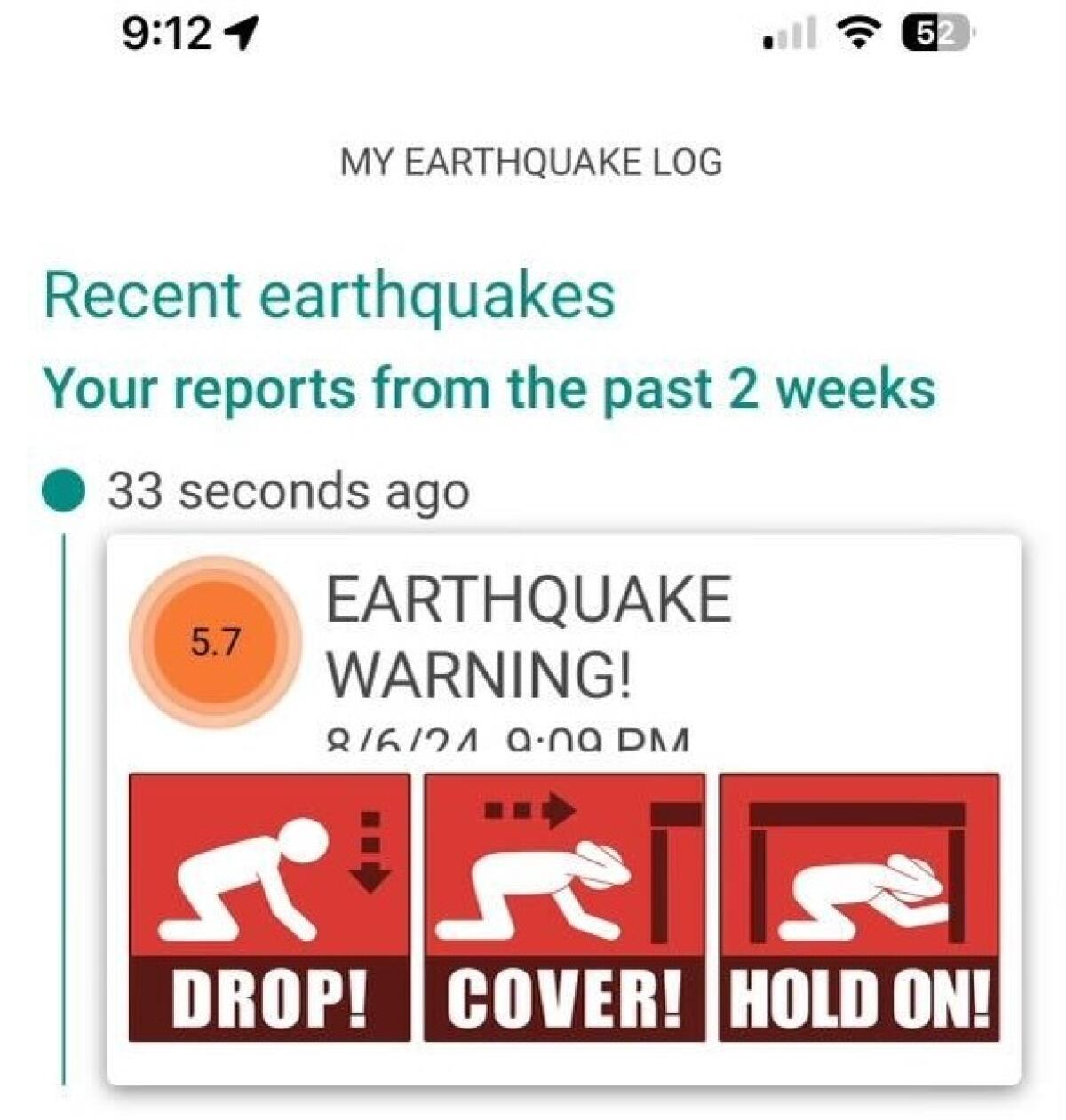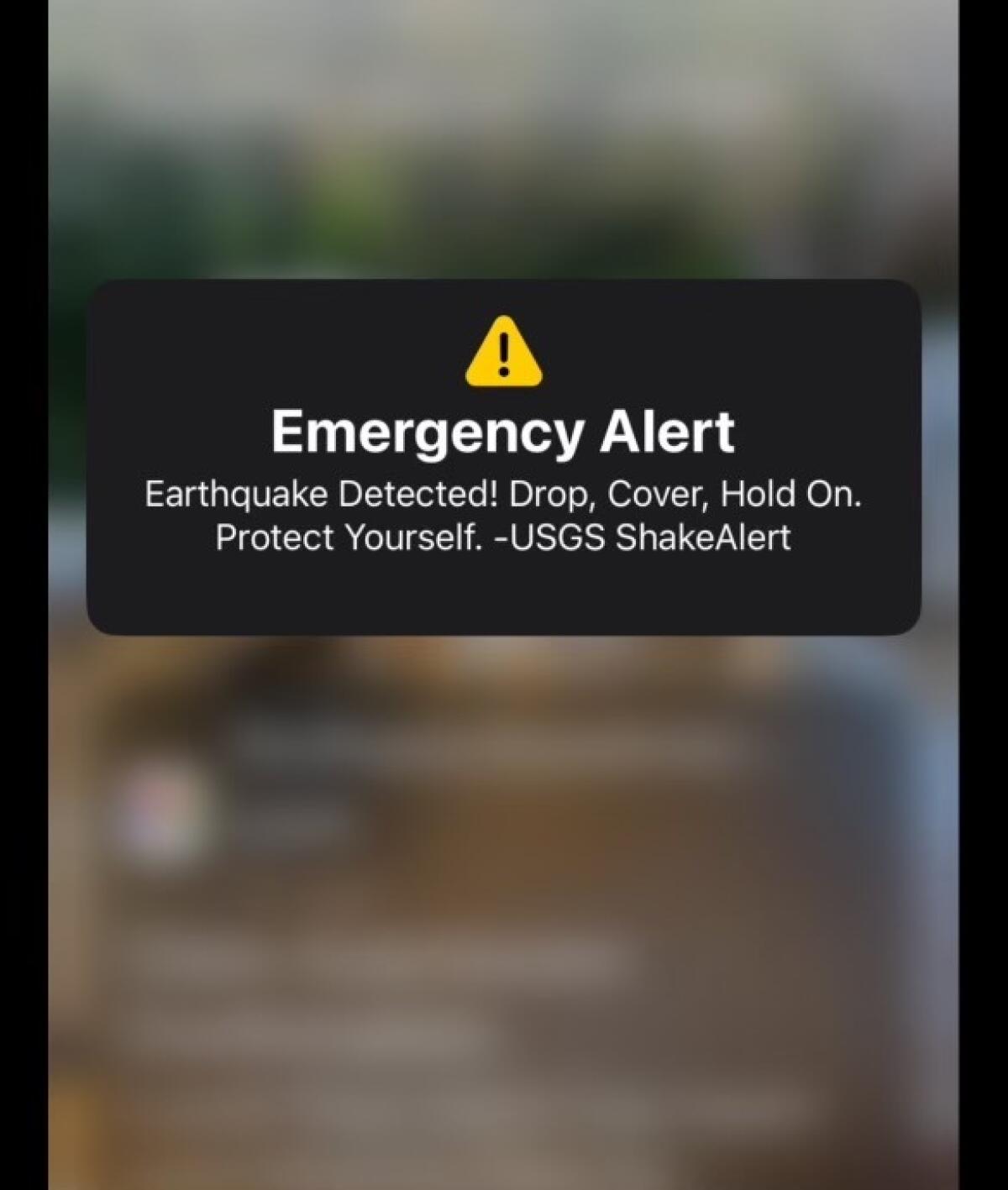[ad_1]
Most Californians know that sinking feeling.
The floor shakes, jolting you to consideration. For a cut up second, your thoughts considers the chances: A truck driving by? Someone dropping a heavy object on the bottom?
The fact, although, rapidly turns into apparent: EARTHQUAKE!
For centuries, that is how folks residing in quake nation have skilled seismic motion. But over the previous couple of years, technological innovation has created another choice: an alarm in your smartphone that offers you a valuable few seconds to organize for the shaking.
California started rolling out free earthquake early-warning apps about 5 years in the past. In 2024, after varied enhancements, a string of average earthquakes and wider use, the community is lastly coming into its personal.
On Tuesday, greater than 5.4 million early-warning alerts went out for the magnitude 5.2 quake that struck Kern County about 18 miles southwest of Bakersfield and 14 miles northwest of the unincorporated neighborhood of Grapevine.
“The heartbeat definitely speeds up, and the adrenaline starts pumping pretty much no matter what,” Jennifer Lazo, chief of the innovation and expertise division at Los Angeles’ Emergency Management Department, stated of receiving the alerts. “But understanding what the noise means, understanding how to quickly look at the message and then quickly take action, I think, is what is key.”
Lazo acquired the alert on her cellphone Tuesday night time as she started to face up within the foyer of the Hollywood Pantages Theatre throughout a present intermission along with her mom. She advised her mother to remain seated till they might make sure the quake wasn’t important.
She and her mom didn’t really feel a lot, however realized after they returned to their seats that many sitting within the viewers had skilled extra shaking.
It was the third time within the final yr that many Southern Californians reported getting the ShakeAlert warnings. Many marvel on the expertise’s capacity to alert them earlier than they really feel shaking, because it did July 29 with a Mojave Desert quake, which was sizable sufficient to really feel a bit scary however to not trigger important injury.
“It’s cool that we have a series of these … ‘big-enough’ earthquakes so that we can exercise the system” and provides “people a chance to get comfortable with earthquake early warning,” stated Robert de Groot, an operations staff chief for the U.S. Geological Survey’s ShakeAlert system, which generates the alerts which are distributed to numerous apps. “That’s really important.”
Scientists need folks to get accustomed to the alerts, which they hope will turn out to be a part of life in California and different earthquake-prone areas of the West Coast.
People reported getting a number of seconds of warning Tuesday earlier than they felt shaking in locations together with Anaheim, Long Beach, Pasadena, Redondo Beach, the San Fernando Valley, the San Gabriel Valley, Ventura and West Los Angeles.

A person in Redondo Beach acquired this alert Tuesday through MyShake, which additionally logs earlier earthquakes.
(Renee Garcia)
Some even reported a 30- to 45-second heads-up earlier than the shaking. They could have been feeling the primary aftershock — a magnitude 4.5 that occurred lower than a minute after the magnitude 5.2 quake.
In West L.A., De Groot stated his spouse first noticed the alert on her cellphone and stated, “What is this Kern County thing?” He stated the preliminary warning estimated that weak shaking was anticipated at their dwelling, and maybe 15 seconds later, they felt it — a shaking he described as a “very gentle back-and-forth” for about 4 seconds.
Tuesday’s magnitude 5.2 earthquake was the greatest to strike Southern California in three years. Other current quakes the place many reported feeling shaking embody July’s magnitude 4.9 temblor centered within the Mojave Desert and final yr’s magnitude 5.1 earthquake close to Ojai in Ventura County, which infamously struck on the identical day a main storm from the weakened Hurricane Hilary loomed over the realm.
Within seconds of Tuesday night time’s quake, the earthquake early-warning system calculated it as a magnitude 6.0, and moments later downgraded it to magnitude 5.7. The USGS web site stated the quake was magnitude 5.3 in its preliminary posting, however later downgraded that to five.2.
There have been, after all, individuals who acquired alerts however didn’t really feel shaking, whereas others near the epicenter — inside 20 miles of the quake’s origin — felt shaking earlier than getting the alert.
But that’s anticipated: It’s a trade-off made within the curiosity of getting alerts out to as many individuals as doable earlier than they really feel an earthquake.
The system works on a easy precept: Shaking from a quake travels on the pace of sound by way of rock — slower than the pace of at the moment’s communications programs. For instance, it might take greater than a minute for a magnitude 7.8 earthquake that begins on the Salton Sea, alongside the state’s longest fault, the San Andreas, to be felt 150 miles away in Los Angeles.
Many folks, nonetheless, aren’t getting the alerts as a result of their telephones don’t have an earthquake early-warning app put in. While Google’s Android working system comes with a built-in app, Apple’s iOS system for iPhones doesn’t.
More than 517,000 alerts have been despatched to MyShake customers, in response to the governor’s workplace, and De Groot stated Google delivered greater than 4.9 million alerts to Android customers.

Much like Amber Alerts, Wireless Emergency Alerts go to cellphones with out particular apps — however just for sturdy earthquakes shut by.
(Robert de Groot / U.S. Geological Survey)
How to get early quake alerts
Those who’ve iPhones can get earthquake early warnings by downloading the free MyShake app, developed by UC Berkeley and offered in partnership with the California Governor’s Office of Emergency Services, which alerts customers in California, Oregon and Washington. San Diego County additionally provides the free SD Emergency app, which incorporates the ShakeReadySD earthquake early-warning software.
People who don’t have smartphones or haven’t put in early-warning apps can nonetheless get quake alerts on their cellphones — however just for these through which the next magnitude or increased degree of shaking is projected at their location. Those alerts are despatched by way of the Wireless Emergency Alert system, just like Amber Alerts.
Android telephones and people with the MyShake or ShakeReadySD apps put in have the bottom threshold for earthquake early warnings: They’re set to set off alerts if a quake is estimated at magnitude 4.5 or increased and the depth of shaking on the cellphone’s location is anticipated to be “weak” — outlined as Level 3 on the Modified Mercalli Intensity Scale.
People who don’t have Android telephones or the apps can nonetheless get early warnings robotically by way of the Wireless Emergency Alert system. Its thresholds are a bit extra conservative, nonetheless: Alerts are triggered to cellphones provided that an earthquake’s magnitude is anticipated to be 5 or increased and the shaking depth is anticipated to be “light,” outlined as Level 4 on the Mercalli scale.
An unknown variety of telephones Tuesday night time acquired Wireless Emergency Alerts.
People could keep in mind downloading an earthquake early-warning app launched by town of Los Angeles on New Year’s Eve in 2018 — ShakeAlertLA — however that app was retired on the finish of 2020.
Scientists urge California residents to obtain the early-warning apps, and say it’s not a nasty thought to have multiple method of getting alerts in your cellphone. MyShake is accessible for each Apple’s iOS and Android.
“It’s worth setting things up. It’s worth getting this technology and using it,” De Groot stated. “It works … it gives us a chance to get comfortable with living” with earthquake early warnings.
Other nations — together with Japan, Mexico, Taiwan and Turkey — have operational early-warning programs. They’re part of life in Japan: Schoolchildren are educated to drop, cowl and maintain on after they hear the alerts; TV exhibits are interrupted by a well-recognized chime with an announcer offering particulars of the anticipated shaking; and cellphones robotically broadcast audible alerts.
On Thursday morning, a magnitude-7.1 earthquake was reported off the jap coast of southern Japan’s foremost island, Kyushu, briefly sparking considerations of a possible tsunami as officers surveyed the area for injury.
No critical injury was reported, in response to space information media, and no tsunamis have been anticipated in California. That earthquake’s epicenter was about 550 miles southwest of Tokyo and about 14 miles southeast of Miyazaki.
Taiwan’s profitable early-warning system generated important consideration in March, with many marveling at tv journalists who alerted viewers concerning the strongest shaking from a magnitude 7.4 earthquake earlier than it arrived of their studio, and continued broadcasting warnings at the same time as they strained to stay standing and ceiling lights clashed collectively.
Initial requires California’s earthquake early-warning system started greater than a decade in the past. Officials say it’s now clear that years of funding, made doable partly by the help of elected officers in Washington and Sacramento, is lastly bearing fruit.
“Our investments in cutting-edge, innovative technologies are paying off. Efforts like these have allowed us to gain vital seconds between when alerts arrive on Californians’ mobile phones and when the ground starts shaking,” Gov. Gavin Newsom, who introduced the MyShake app launch in 2019, stated in a assertion Wednesday.
“Californians, I encourage you to download the app,” he added. “It can save lives!”
It could be a little alarming to get your first alert, however the system may also help prepare Californians to organize for larger earthquakes.
Seeing the alerts work in actual life and never simply as a theoretical train has been thrilling, stated Lazo, of L.A.’s Emergency Management Department.
“It shows a lot of hard science at work that’s actually going to have an impact on the public and hopefully make people safer,” she stated. “And that is a great thing to see. It’s such a new frontier for us in earthquake response.”
Times workers writers Luke Money, Joseph Serna and Ruben Vives contributed to this report.
[ad_2]
Source

